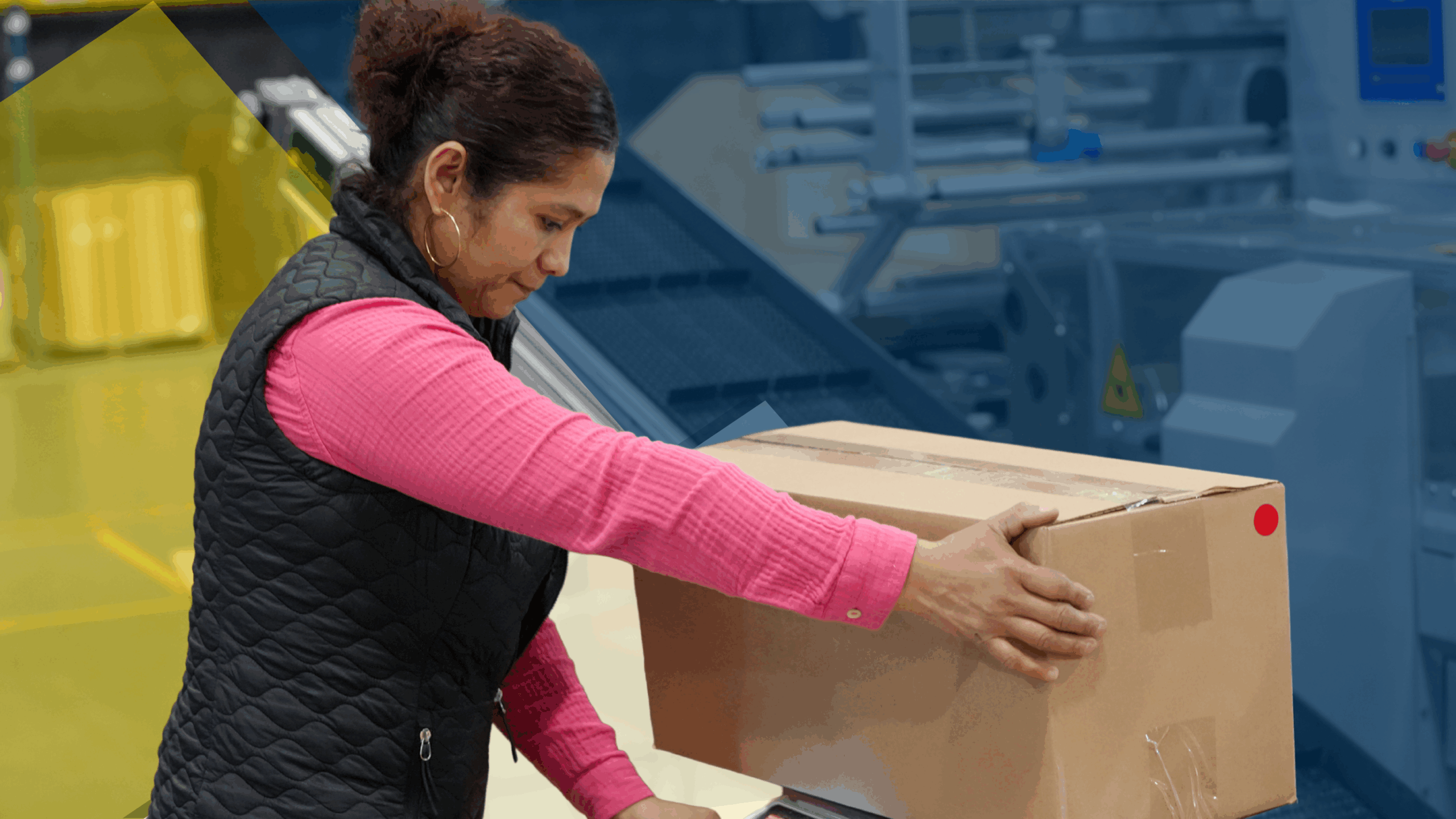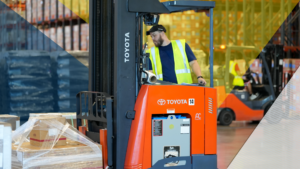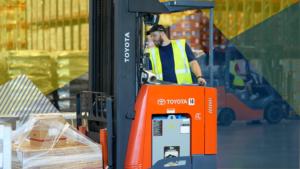In an increasingly ecommerce-driven world, getting products into customers’ hands quickly and efficiently is more important than ever—and that’s where third-party logistics providers, or 3PLs, come in. A 3PL is a company that handles logistics services on behalf of another business, including warehousing, order fulfillment, inventory management, and shipping, and the need for 3PLs is on the rise in Kansas City and across the country. Rather than managing these complex and time-consuming operations in-house, many brands rely on 3PLs to streamline the entire fulfillment process, reduce overhead, and scale more easily as they grow. Crucially, 3PLs also help companies reduce shipping fees.
This article breaks down exactly how a 3PL ships a package—from the moment inventory arrives at their warehouse to the final delivery at a customer’s doorstep—taking a comprehensive look at how 3PLs keep supply chains moving.
The 3PL Shipping Process – Step-by-Step
Shipping a package through a 3PL involves a finely tuned sequence of operations designed to ensure speed, accuracy, and efficiency. Here’s a detailed look at each stage of the process:
Step 1. Integration & Onboarding
The journey begins with integrating the client’s eCommerce platform—such as Shopify, Amazon, WooCommerce, or BigCommerce—with the 3PL’s fulfillment software. This connection allows for seamless, real-time data exchange, including order details, tracking information, and inventory levels. During onboarding, the product catalog is synced, SKUs are mapped, and inventory rules are established. The client and 3PL also define service level agreements (SLAs), such as expected fulfillment times and shipping cutoffs, and agree on communication protocols to ensure transparency and accountability throughout the partnership.
The integration and onboarding phase for a 3PL shipping a package involves several structured steps to ensure a seamless, efficient fulfillment process. Here’s a breakdown of the typical steps:
Initial Consultation & Needs Assessment
- Understand the client’s business model, sales channels, products, and fulfillment needs.
- Discuss volume expectations, special requirements (e.g., kitting, fragile items), and future scaling plans.
Platform & System Integration
- Connect the client’s eCommerce platform(s) to the 3PL’s system using APIs, apps, or middleware (e.g., for Shopify, Amazon, WooCommerce, etc.).
- Ensure two-way data flow for:
- Orders
- Inventory updates
- Tracking information
- Returns and restocks
Product Catalog Upload & SKU Mapping
- Import the client’s full product catalog into the 3PL’s Warehouse Management System (WMS).
- Assign or verify SKU numbers.
- Input product dimensions, weights, and any handling/storage instructions.
Inventory Strategy Setup
- Define inventory receiving guidelines.
- Choose inventory rotation methods (e.g., FIFO, LIFO).
- Determine storage strategies (bins, racking, pallets, temperature-controlled zones, etc.).
Shipping & Fulfillment Rule Configuration
- Set up order routing logic, shipping methods, and packaging rules.
- Determine carrier preferences (e.g., cheapest rate, fastest delivery, eco-friendly options).
- Configure shipping cut-off times, custom branding, and packaging preferences.
Service Level Agreements (SLAs) & Reporting Setup
- Agree on fulfillment and shipping timelines (e.g., same-day, next-day).
- Define acceptable error rates and dispute handling procedures.
- Set up automated performance reports and KPIs tracking (e.g., order accuracy, on-time shipments).
Test Orders & Workflow Validation
- Run test orders through the full process to validate:
- Order transmission
- Picking and packing
- Label generation
- Tracking updates
- Troubleshoot and fine-tune integrations or workflow issues.
Staff Training & Communication Protocols
- Introduce the client to their account manager or dedicated support team.
- Provide access and training on the 3PL’s dashboard or client portal.
- Set communication expectations, including how and when to report issues.
Go-Live & Inventory Receiving
- Schedule and execute the initial inventory inbound shipment.
- Receive, inspect, and store inventory in the 3PL’s warehouse.
- Officially start live fulfillment and shipping.
Step 2. Receiving Inventory
Once integration is complete, the client ships their products to the 3PL’s warehouse. Upon arrival, the items go through a receiving process that includes inspection for damage or discrepancies, sorting, and labeling if necessary. Inventory is then stored using racking systems, bins, or shelving units, based on the product’s size and turnover rate. Many 3PLs use inventory management strategies like FIFO (First In, First Out) or LIFO (Last In, First Out) to control stock rotation, particularly for perishable or seasonal items.
Receiving inventory is a critical part of the 3PL shipping process—it sets the stage for accurate order fulfillment and efficient warehouse operations. Here’s a detailed breakdown of the steps involved in receiving inventory at a 3PL:
Advance Shipment Notification (ASN)
- The client sends a detailed inbound shipping notice to the 3PL before the inventory arrives.
- This includes:
- Expected delivery date and carrier
- SKU list with quantities
- Packaging type (e.g., pallets, cartons, individual units)
- Any special handling instructions
Delivery Arrival & Unloading
- Inventory arrives at the 3PL warehouse via freight, parcel, or container shipment.
- Warehouse staff verifies the shipment against the ASN.
- Goods are unloaded at the receiving dock.
Inspection & Verification
- Each shipment is inspected for:
- Damage during transit
- Accuracy of items and quantities vs. packing slip or ASN
- Compliance with labeling and packaging requirements
- Discrepancies (overages, shortages, damages) are documented and reported to the client.
Labeling & Barcoding
- If not already labeled, SKUs are tagged with internal barcodes or labels that match the 3PL’s tracking system.
- This ensures the inventory can be easily scanned and tracked throughout the warehouse.
Sorting & Categorization
- Items are sorted by SKU, product type, or storage method.
- If kitting or pre-assembly is required, it may happen at this stage or be scheduled separately.
Inventory Putaway
- Products are placed into designated storage locations based on:
- Product size and weight
- Turnover rate (high-frequency items near packing stations)
- Inventory strategy (FIFO, LIFO, FEFO, etc.)
- Items are scanned into their bin, shelf, or pallet location in the warehouse management system (WMS).
System Update & Inventory Sync
- The WMS is updated with the new stock levels and exact storage locations.
- Real-time sync ensures that the client’s dashboard and eCommerce platforms reflect accurate inventory counts.
Confirmation & Reporting
- A receiving report is generated and sent to the client.
- This report typically includes:
- Received SKUs and quantities
- Any discrepancies or issues
- Inventory now ready for fulfillment
Step 3. Order Processing
When a customer places an order through the brand’s website or marketplace, it is automatically transmitted to the 3PL’s system through the integrated platform. Orders are synced in real time, ensuring that fulfillment starts as quickly as possible. The 3PL’s software generates a pick list for warehouse staff, identifying the exact SKUs and storage locations needed to fulfill the order.
Order processing is where the real magic begins in a 3PL’s fulfillment workflow—it’s the bridge between an online purchase and a shipped package. Once inventory is received and stored, the next big job is processing customer orders quickly and accurately. Here’s a step-by-step breakdown of the order processing workflow for a 3PL:
Order Capture
- Customer places an order on the client’s online store (e.g., Shopify, Amazon, WooCommerce).
- The order is automatically transmitted to the 3PL via system integration (API or app).
- Orders are pulled into the 3PL’s Warehouse Management System (WMS) in real time or in scheduled sync intervals.
Order Validation & Screening
- The 3PL system checks for:
- Inventory availability
- Fraud alerts or flagged addresses
- Order completeness (valid SKUs, correct shipping info)
- If there are issues (e.g., out-of-stock items), the order may be placed on hold and flagged for client review.
Picking List Generation
- A pick list is created for each order or batch of orders.
- This list contains:
- SKUs and quantities
- Bin or shelf locations in the warehouse
- Special instructions (e.g., fragile, perishable, gift wrap)
- The pick list is sent to warehouse staff, often via handheld barcode scanners or mobile devices.
Inventory Allocation
- Items are reserved in the system so they can’t be picked for other orders.
- This prevents double-selling and maintains inventory accuracy across channels.
Order Routing (if using multiple warehouses)
- If the 3PL has multiple fulfillment centers, the system determines which location should process the order.
- Decisions are based on:
- Proximity to the customer
- Inventory availability
- Shipping cost or speed
Status Update & Client Notification
- Once an order is picked and queued for packing, its status is updated in the WMS.
- Some 3PLs send a status change back to the client’s eCommerce platform (e.g., “Order in fulfillment”).
- At this point, the fulfillment team takes over for packing and shipping.
Step 4. Picking & Packing
Warehouse associates use barcode scanners and pick lists to retrieve the correct products from storage, reducing the chances of errors. Once items are picked, they are moved to a packing station where they are carefully packaged using materials suited to the product—such as boxes, bubble wrap, kraft paper, or branded packaging elements. If the brand offers kitting or product bundling, those steps happen here. Each package goes through a final quality check to confirm accuracy before sealing and labeling.
The picking and packing phase is at the heart of order fulfillment for a 3PL. It’s where accuracy, speed, and efficiency all come into play to ensure customers get the right products delivered in perfect condition. Here’s a breakdown of the step-by-step process involved in picking and packing when a 3PL ships a package:
Pick List Generation
- Once an order is processed, the system creates a pick list.
- This document (often digital and accessed via scanners or tablets) includes:
- SKU numbers
- Product names
- Quantities
- Storage/bin locations
- Orders may be picked individually or in batches (batch picking or wave picking) to maximize efficiency.
Item Picking
- A warehouse associate (picker) follows the pick list to locate and retrieve the items.
- Barcode scanners are used to verify that the correct products are picked.
- Items are placed in a tote or cart designated for that specific order or batch.
Picking Accuracy Check (Optional)
- Some 3PLs include a checkpoint before packing to verify picked items.
- This may involve rescanning or weighing items to catch any discrepancies before packing.
Packing Station Transfer
- Picked items are transferred to a packing station, where a packer prepares them for shipment.
- Orders are cross-checked again to confirm accuracy.
Packaging Selection
- The packer chooses appropriate packaging materials based on:
- Product size, weight, and fragility
- Branding requirements (custom boxes, inserts, stickers)
- Sustainability preferences (recyclable or biodegradable materials)
- Common materials include boxes, poly mailers, bubble wrap, air pillows, kraft paper, and tape.
Kitting or Assembly (If Applicable)
- If the order involves multiple items being grouped into one product (e.g., a gift set), kitting is performed.
- This can include bundling products, adding instructions, or custom assembly based on client needs.
Final Quality Control Check
- Before sealing the package, a final check ensures:
- All ordered items are included
- Items are not damaged
- The correct shipping label is applied
- This reduces fulfillment errors and returns.
Shipping Label Generation
- The system selects the most efficient carrier based on rules (cost, speed, destination).
- A shipping label is generated, printed, and applied to the package.
- Tracking information is pushed back to the client’s eCommerce platform and shared with the customer.
Package Sorting for Carrier Pickup
- Packed orders are sorted by carrier and staged at designated pickup areas.
- Some warehouses may separate by shipping method (e.g., standard, express) as well.
Step 5. Shipping the Package
Next, the 3PL determines the most cost-effective and timely shipping method by comparing rates and transit times across multiple carriers like USPS, UPS, FedEx, and DHL. Once the best option is selected, a shipping label is generated, and the package is prepared for pickup. Tracking information is automatically sent to the customer, and many 3PLs offer same-day shipping for orders placed before a designated cut-off time.
Shipping the package is the final stretch in the 3PL fulfillment process—where everything from inventory planning to picking and packing comes together. It’s not just about sticking a label on a box; it involves strategic decisions and tech-driven processes to ensure fast, affordable, and reliable delivery. Here’s a step-by-step breakdown of the shipping phase for a 3PL:
Carrier Selection & Rate Shopping
- The 3PL’s system compares shipping options across multiple carriers (e.g., USPS, UPS, FedEx, DHL).
- Selection is based on:
- Delivery speed (standard, express, 2-day, overnight)
- Shipping destination (domestic vs. international)
- Package weight, dimensions, and value
- Client preferences (e.g., eco-friendly options or negotiated carrier rates)
- The goal is to choose the most cost-effective and efficient option for each order.
Shipping Label Generation
- Once the carrier is chosen, the system generates a shipping label that includes:
- Recipient’s name and address
- Return address (often the 3PL or client’s info)
- Tracking number and barcodes
- Service level (e.g., Ground, 2-Day Air)
- The label is printed and affixed to the package.
Tracking Info Sync
- Tracking numbers are automatically sent to:
- The client’s eCommerce platform (e.g., Shopify, Amazon, WooCommerce)
- The end customer (via email or SMS)
- This allows customers to track their package from warehouse to doorstep.
Cut-Off Times and Same-Day Shipping
- Most 3PLs have daily cut-off times (e.g., 2 PM local time) for same-day fulfillment.
- Orders received before the cut-off are picked, packed, and shipped that same day.
- Orders received after the cut-off are queued for the next business day.
Package Sorting & Carrier Staging
- Labeled packages are sorted by shipping carrier and sometimes by service level (e.g., standard vs. expedited).
- This organization speeds up the pickup process and ensures accurate handoff.
Carrier Pickup Scheduling
- The 3PL schedules daily pickups with each carrier.
- Pickup frequency may vary depending on order volume, location, and carrier agreements.
Scanning & Entry into Carrier System
- When the carrier arrives, each package is scanned into their system.
- This “first scan” officially begins the shipment journey and activates tracking for the customer.
- From here, the package is transported to the nearest sorting hub and then routed to its final destination.
Step 6. Handoff to Carrier
Finally, the packaged orders are staged for pickup based on their designated carriers. Scheduled pickups occur daily or multiple times a day, depending on volume and agreements with each shipping service. When carriers arrive, packages are scanned into their systems, officially entering the shipping network. From here, the carrier takes over the final leg of delivery, while both the customer and the brand can monitor progress via tracking updates.
The handoff to the carrier is the final internal step before a package begins its journey to the customer. It’s crucial for ensuring accurate tracking, timely delivery, and a seamless transition between the 3PL and the shipping provider. Here’s a breakdown of the handoff to carrier process for a 3PL shipping a package:
Final Package Sorting
- Packed and labeled orders are grouped by carrier (e.g., USPS, UPS, FedEx, DHL).
- Within each carrier group, packages may also be sorted by:
- Shipping speed (standard, express)
- Destination region or zone
- Sorting ensures a smooth and organized pickup process.
Carrier Pickup Scheduling
- The 3PL schedules daily or multiple pickups with each carrier based on volume and cut-off times.
- Some 3PLs have standing agreements with carriers for specific pickup windows, while others may request pickups as needed.
Loading for Carrier Pickup
- Packages are scanned and moved to designated pickup areas or docks.
- Warehouse staff assist in loading packages into the carrier’s vehicle.
- In high-volume environments, pallets or rolling bins may be used to batch-transport packages to the trucks.
Carrier Scan & Acceptance
- Each package is scanned by the carrier upon pickup.
- This “first physical scan” officially enters the shipment into the carrier’s tracking system.
- From this point forward, the carrier takes ownership of the package’s delivery timeline.
Tracking Activation & Handoff Confirmation
- The carrier scan activates real-time tracking for the customer and the seller.
- A digital handoff receipt is often generated and stored in the 3PL’s system to confirm transfer of custody.
- The client (merchant) can now monitor delivery status through the carrier or via their 3PL’s dashboard.
Delivery Journey Begins
- The carrier transports the package to their nearest sorting facility, then routes it through their logistics network.
- From here, the 3PL’s role in the fulfillment process is complete, and the carrier takes over until final delivery to the customer.
Simplify Your Shipments with Nautical Manufacturing & Fulfillment
Partner with a 3PL that handles the entire shipping process—from seamless integrations to doorstep delivery—with speed, accuracy, and care. Whether you’re scaling fast or just getting started, we’ve got the tech, team, and warehouse network to help you grow.
Contact us today to see how our end-to-end fulfillment solutions can power your eCommerce success.




